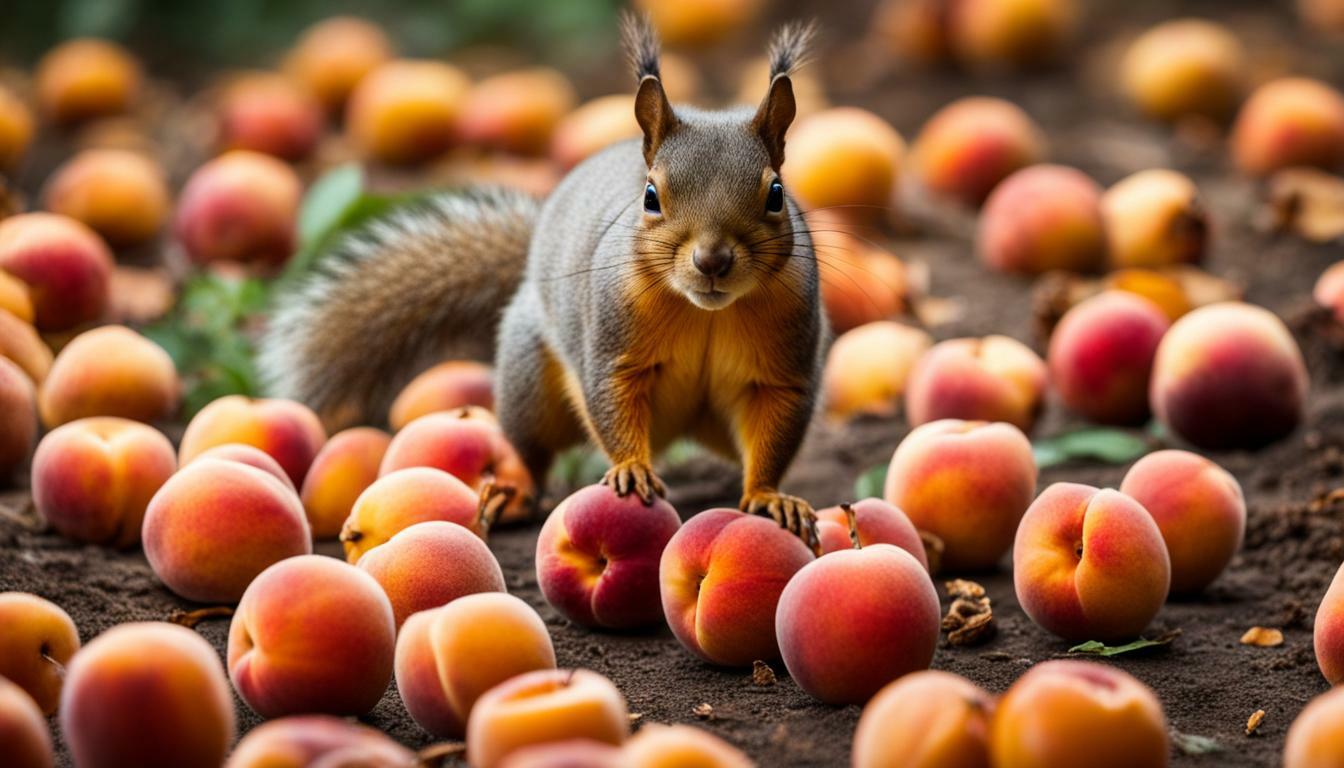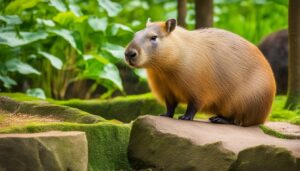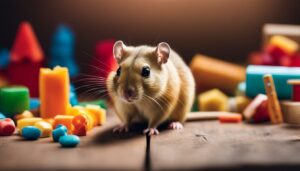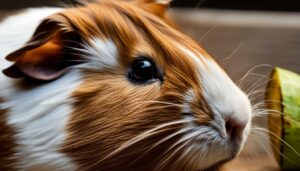Squirrels are known for their varied diet, but have you ever wondered if they eat peach pits? In this article, we will explore squirrel behavior and their diet to uncover the truth about peach pit consumption.
Key Takeaways:
- Squirrels do eat peach pits, although they prefer the flesh of the peach.
- Consuming too many peach pits can lead to digestive issues due to the small amount of cyanide they contain.
- It is recommended to feed squirrels fresh or dried peaches with the pit removed to avoid health problems.
- When feeding peaches to baby squirrels, always remove the pit before giving it to them.
- To protect your peach trees from squirrels, consider using physical barriers such as fences or repellents like motion-activated sprinklers.
Squirrel Food Preferences
Squirrels are opportunistic eaters and will consume a wide range of foods, including nuts, seeds, fruits, and even bird eggs. Their diet can vary depending on what is available in their habitat and the time of year. In urban areas, squirrels often rely on human food sources such as bird feeders and garbage cans.
When it comes to nuts, squirrels have a preference for acorns, walnuts, and hickory nuts. They also enjoy feasting on seeds like sunflower seeds and pumpkin seeds. In terms of fruits, squirrels have a sweet tooth and are particularly fond of apples, berries, and peaches. However, while they may eat the flesh of peaches, they are more cautious when it comes to the pits.
Squirrel Diet
While squirrels do eat peach pits, their consumption is limited. The pits contain a small amount of cyanide, which can be harmful in large quantities. As a result, squirrels may nibble on the pit but won’t consume it in large quantities. If you want to feed squirrels peaches, it is best to remove the pit to avoid any potential digestive issues.
If you have peach trees in your garden and want to protect them from squirrels, there are a few options. One method is to create physical barriers, such as fences or netting, to prevent squirrels from accessing the fruit. Another option is to use repellents, such as motion-activated sprinklers, which will deter squirrels from approaching the trees.
| Preferred Foods | Occasional Foods | Less Preferred Foods |
|---|---|---|
| Nuts: acorns, walnuts, hickory nuts | Bird eggs | Insects |
| Seeds: sunflower seeds, pumpkin seeds | Berries | Leaves |
| Fruits: apples, berries, peaches | Vegetables | Grass |
The Peach Pit Mystery
Peach pits, also known as peach seeds, have long been a subject of curiosity when it comes to squirrel behavior. You may have wondered if squirrels eat these pits or if they can safely consume them. Well, the answer is yes, squirrels do eat peach pits, but it’s not their preferred snack. Squirrels are more interested in the juicy flesh of peaches, but if they’re feeling hungry, they might take a nibble on the pit.
However, it’s important to note that consuming too many peach pits can lead to digestive issues for squirrels. Peach pits contain a small amount of cyanide, which can be harmful if ingested in large quantities. To ensure the health and safety of the squirrels, it is recommended to feed them fresh or dried peaches with the pit removed. This way, they can enjoy the tasty fruit without any potential risks.
If you have baby squirrels around, you might be wondering if it’s safe for them to eat peaches, including the pits. While baby squirrels can indeed eat peaches, it’s crucial to remove the pit before giving it to them. The size of the pit could pose a choking hazard, so it’s best to play it safe and provide them with pit-free peach slices.
| Fact | Recommendation |
|---|---|
| Peach pits contain cyanide. | Feed squirrels fresh or dried peaches without the pit. |
| Baby squirrels can eat peaches. | Always remove the pit before feeding them. |
If you’re growing peach trees and want to protect them from squirrel damage, there are a few methods you can try. One option is to create physical barriers around the trees, such as fences or netting. These barriers will prevent squirrels from accessing the peaches and potentially eating the pits. Another effective method is to use repellents, such as motion-activated sprinklers. These devices release a burst of water when they detect movement, which can startle and deter squirrels from approaching your peach trees.
Squirrels and Peach Pits
Yes, squirrels do eat peach pits, although they prefer the flesh of the peach itself. The sweet and juicy fruit is their favorite part, but if they are feeling hungry, they will nibble on the pit as well. It’s important to note, however, that consuming too many peach pits can lead to digestive issues for squirrels.
Peach pits contain a small amount of cyanide, a toxic substance that can be harmful if ingested in large quantities. While the amount of cyanide in a single peach pit is typically not enough to cause severe harm, it’s best to avoid feeding squirrels excessive amounts of pits. To ensure the safety of these furry creatures, it is recommended to feed them fresh or dried peaches with the pits removed.
When it comes to baby squirrels, they can also eat peaches, but extra caution should be taken. Before offering peaches to baby squirrels, the pit must be removed completely as it poses a choking hazard. It’s essential to prioritize the safety and well-being of these young animals by providing them with the appropriate food.
If you have peach trees and want to protect them from squirrels, there are a few strategies you can employ. Physical barriers such as fences or netting can be effective in preventing squirrels from accessing the peaches. Additionally, you can use repellents like motion-activated sprinklers to deter squirrels from approaching the trees. By implementing these measures, you can safeguard your peach trees and ensure that both squirrels and peaches can coexist harmoniously.
| Squirrels and Peach Pits | Protecting Peach Trees from Squirrels |
|---|---|
| Yes, squirrels eat peach pits, though they prefer the flesh of the peach itself. | Physical barriers such as fences or netting can prevent squirrels from accessing peaches. |
| Peach pits contain a small amount of cyanide, which can cause digestive issues if consumed in excess. | Using motion-activated sprinklers can help deter squirrels from approaching peach trees. |
| It is recommended to feed squirrels fresh or dried peaches with the pits removed. | By implementing these measures, you can protect your peach trees while ensuring the well-being of squirrels. |
Cyanide Content in Peach Pits
Peach pits contain a small amount of cyanide, which can be harmful if consumed in large quantities by squirrels. While squirrels do eat peach pits, it is important to understand the potential risks associated with their consumption. The cyanide content in peach pits is generally not harmful to squirrels when consumed in small amounts. However, if a squirrel ingests a large quantity of peach pits, it can cause digestive issues and potentially lead to cyanide poisoning.
To mitigate the risks, it is recommended to feed squirrels fresh or dried peaches with the pit removed. This ensures that they can enjoy the tasty flesh of the peach without ingesting excessive amounts of cyanide. Additionally, it is essential to remove the pit before offering peaches to baby squirrels. Their smaller size and developing digestive systems make them more vulnerable to the potential dangers of peach pit ingestion.
Protecting your peach trees from squirrels can also help prevent them from consuming large quantities of peach pits. One effective method is to create physical barriers such as fences or netting around the trees. This prevents squirrels from reaching the peaches in the first place. Another option is to use repellents, such as motion-activated sprinklers, which startle and deter squirrels from approaching the trees. These methods can help safeguard both the squirrels and your peach harvest.
| Pros | Cons |
|---|---|
| Feeding squirrels fresh or dried peaches without pits eliminates the risk of cyanide ingestion. | Removing peach pits can be time-consuming and tedious, especially when feeding a large population of squirrels. |
| Creating physical barriers such as fences prevents squirrels from accessing peaches and potentially consuming large quantities of pits. | Physical barriers may require regular maintenance and can be costly to install, especially in larger areas. |
| Using motion-activated sprinklers can effectively deter squirrels from approaching peach trees and reduce the risk of peach pit ingestion. | Motion-activated sprinklers may need to be adjusted or replaced over time, and they rely on a water source. |
Feeding Recommendations
To ensure the health and well-being of squirrels, it is recommended to feed them fresh or dried peaches with the pits removed. While squirrels do eat peach pits, it is best to avoid giving them to the furry critters due to the small amount of cyanide content, which can cause digestive issues.
When offering peaches as a treat, make sure to remove the pits beforehand. Squirrels will happily munch on the flesh of the peach, but it’s essential to keep them safe from potential harm. Providing fresh or dried peaches without the pits is a safer option for their diet.
If you come across baby squirrels that are in need of feeding, you can also offer them peaches. However, it’s crucial to remove the pits first to prevent any choking hazards. Baby squirrels have delicate digestive systems, and providing them with pit-free peaches ensures their safety.
For those concerned about protecting their peach trees from squirrel damage, there are a few strategies to consider. Creating physical barriers, such as fences or netting, can effectively keep squirrels away from the tempting fruit. Another option is using motion-activated sprinklers as a deterrent, as the sudden burst of water will discourage squirrels from approaching the trees.
| Feeding Recommendations | Protecting Peach Trees |
|---|---|
|
|
Baby Squirrels and Peach Pits
Baby squirrels can eat peaches, but it is crucial to remove the pit before offering it to them to avoid any potential hazards. While the flesh of the peach is safe and enjoyable for squirrels, the pit poses a risk due to its small amount of cyanide content. It’s essential to prioritize the well-being of these adorable little creatures and ensure their safety when feeding them.
Here are some guidelines to follow when feeding peaches to baby squirrels:
- Always remove the pit from the peach before giving it to the baby squirrel.
- Ensure the peach is fresh and ripe, providing the squirrel with the best nutritional value.
- Chop the peach into small, manageable pieces for the baby squirrel.
- Offer the peach as a treat in addition to their regular diet of nuts, seeds, and other squirrel-friendly foods.
- Observe the baby squirrel while it eats to ensure it can handle the peach pieces and doesn’t experience any choking hazards.
By taking these precautions, you can safely introduce peaches into a baby squirrel’s diet and provide them with a diverse range of flavors and nutrients. Remember, their health and well-being should always be the top priority.
| Nutritional Facts of Peaches | |
|---|---|
| Vitamin C | 9.9 mg |
| Vitamin A | 326 IU |
| Potassium | 285 mg |
| Dietary Fiber | 2.0 g |
Protecting Peach Trees from Squirrels
If you’re concerned about squirrels damaging your peach trees, there are a few strategies you can employ to deter them. Squirrels are known for their climbing abilities and determination to access tasty treats, so it’s important to take proactive measures to protect your trees.
Physical Barriers
One effective method to keep squirrels away from your peach trees is by using physical barriers. Fencing is a popular option, as it creates a physical barrier that prevents squirrels from accessing the tree. Choose a sturdy material that squirrels cannot easily chew through.
Another option is netting, which can be draped over the tree to keep squirrels from reaching the peaches. Make sure the netting is tightly secured to prevent squirrels from squeezing through gaps. However, be cautious when using netting to avoid unintentionally trapping other wildlife.
| Physical Barriers | Pros | Cons |
|---|---|---|
| Fences | Strong deterrent, prevents access to trees | Requires installation, can be visually unappealing |
| Netting | Effective at keeping squirrels away | May require maintenance, potential risk to other wildlife |
Repellents for Squirrel Control
Another option to protect your peach trees is by using repellents that deter squirrels. Motion-activated sprinklers are particularly effective as they startle squirrels with a sudden burst of water. This disrupts their behavior and teaches them to stay away from the area.
When using repellents, it’s important to follow the instructions carefully and apply them in the appropriate areas. Be mindful of any potential harm or discomfort the repellent might cause to wildlife or pets.
- Motion-activated sprinklers
- Emits sudden bursts of water to startle squirrels
- Teaches squirrels to avoid the area
By implementing these strategies, you can help protect your peach trees from squirrel damage and ensure a bountiful harvest. Remember to consider the local regulations and any potential impact on other wildlife when selecting your chosen method of squirrel deterrence.
Physical Barriers
Installing physical barriers around your peach trees can be an effective way to keep squirrels from reaching the fruit, including the pits. These barriers create a physical obstacle that squirrels find difficult to overcome, discouraging them from accessing the trees. There are several options for implementing physical barriers:
- Fences: Erecting a fence around the perimeter of your peach trees can help prevent squirrels from getting too close. Choose a fence with small openings or install a wire mesh to make it more difficult for squirrels to squeeze through.
- Netting: Covering your peach trees with netting can provide an additional layer of protection. Make sure the netting is secured tightly so that squirrels cannot push through or chew through it.
- Tree Wraps: Using tree wraps made of metal or plastic can create a smooth surface that squirrels struggle to climb. Wrap the trunks of your peach trees with these materials, starting from the base and extending several feet upward.
Remember to regularly inspect and maintain your physical barriers to ensure they remain intact and effective. Patch any holes in fences or netting and replace tree wraps as needed. It’s also important to monitor your peach trees for any signs of squirrel activity, such as chewed leaves or fruits on the ground.
Table: Pros and Cons of Physical Barriers
| Pros | Cons |
|---|---|
| Effectively deter squirrels | Requires upfront cost and effort |
| Can be used in combination with other deterrents | May impact aesthetics of your orchard |
| Provides long-lasting protection | Requires regular maintenance and inspection |
In addition to physical barriers, it’s important to consider other preventive measures to further discourage squirrels from targeting your peach trees. Removing fallen fruit from the ground promptly and keeping the area around the trees clean can help reduce the incentive for squirrels to visit. Additionally, consider planting squirrel-resistant plants or using squirrel repellents to create a less appealing environment for these critters.
By implementing physical barriers and taking additional preventive steps, you can protect your peach trees from squirrel damage and ensure that your harvest remains intact.
Repellents for Squirrel Control
Motion-activated sprinklers are an environmentally friendly and humane way to discourage squirrels from feasting on your peach tree’s fruit. These innovative devices are designed to detect the movement of squirrels and other animals, triggering a burst of water that startles them and encourages them to leave your garden or orchard. By using motion-activated sprinklers, you can protect your peach trees without causing harm to the squirrels.
In addition to being safe for wildlife, motion-activated sprinklers offer several advantages. First, they are highly effective in deterring squirrels, as the sudden spray of water surprises and scares them away. The sprinklers can be set to activate during the times when squirrels are most active, such as dawn and dusk. This ensures maximum protection for your peach trees when the squirrels are most likely to target them.
Furthermore, motion-activated sprinklers are easy to install and require minimal maintenance. Simply connect them to a water source, adjust the sensitivity and range settings, and position them strategically around your peach trees. Most motion-activated sprinklers have adjustable settings, allowing you to customize the spray distance and duration. Some models even come with multiple sensors to cover a larger area.
| Advantages of Motion-Activated Sprinklers |
|---|
| 1. Environmentally friendly and humane |
| 2. Highly effective in deterring squirrels |
| 3. Easy to install and require minimal maintenance |
By using motion-activated sprinklers, you can enjoy the beauty and abundance of your peach trees without worrying about squirrel damage. These devices provide a safe and effective way to protect your peach tree’s fruit, allowing you to savor the tasty peaches while keeping the squirrels at bay. So, set up your motion-activated sprinklers today and enjoy a squirrel-free harvest!
Conclusion
In conclusion, squirrels do eat peach pits, but it is important to be mindful of the potential risks associated with peach pit ingestion and to take appropriate measures to protect your peach trees from squirrel damage.
Factual data shows that while the flesh of the peach is a squirrel’s favorite part, they will nibble on the pit if they are feeling peckish. However, consuming too many peach pits can lead to digestive issues since they contain a small amount of cyanide. To ensure the well-being of squirrels, it is recommended to feed them fresh or dried peaches with the pit removed.
If you have baby squirrels in your vicinity, they can also enjoy peaches, but make sure to remove the pit before offering it to them. This precaution is necessary to prevent any potential harm to their delicate digestive systems.
To protect your precious peach trees from squirrel damage, there are a couple of effective methods you can employ. One option is to create physical barriers such as fences or netting that prevent squirrels from accessing the peaches. Another option is to use repellents like motion-activated sprinklers, which deter squirrels from approaching your trees. By implementing these measures, you can enjoy the beauty and bounty of your peach trees without the worry of squirrel interference.
FAQ
Do squirrels eat peach pits?
Yes, squirrels do eat peach pits. While the flesh of the peach is their favorite part, squirrels will nibble on the pit if they are feeling peckish.
Are peach pits safe for squirrels to eat?
Consuming too many peach pits can lead to digestive issues for squirrels since they contain a small amount of cyanide. It is recommended to feed squirrels fresh or dried peaches with the pit removed.
Can baby squirrels eat peaches with the pit?
Baby squirrels can also eat peaches, but the pit should be removed before giving it to them. It is important to ensure their safety and prevent any potential choking hazards.
How can I protect my peach trees from squirrels?
To protect your peach trees from squirrels, you can create physical barriers such as fences or use repellents like motion-activated sprinklers.




